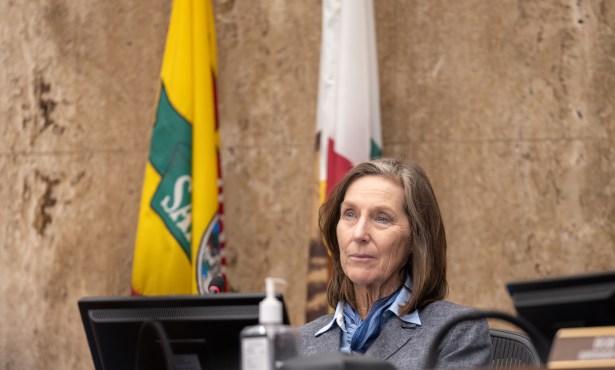Endorsements for
the March 5, 2024
Presidential Primary Election
Our Picks for U.S. President
and 24th Congressional District,
State Assembly and Senate, and
County Board of Supervisors
By Indy Staff | February 15, 2024
Over the next couple of weeks, the Santa Barbara Independent will be rolling out its endorsements for the March 5, 2024, primary election. If you are surprised to learn there’s an election coming right up, you are hardly alone. In all the din of national and international news, the local and statewide races have not gotten the attention they should. Because of that, turnout is expected to be low. As a result, your vote matters more than ever.
Check our Election 2024 section for continuing information on this year’s primary and general elections. As always, the Independent only endorses in races that we have researched carefully. Thank you for considering our suggestions.
Register to vote at registertovote.ca.gov.
Endorsements So Far
U.S. President:
Joe Biden
U.S. Representative, 24th Congressional District:
Salud Carbajal
State Senator, 21st District:
Monique Limón
Member of the State Assembly, 37th District:
Gregg Hart
County Supervisor, 1st District:
No Endorsement
County Supervisor, 3rd District:
Joan Hartmann
Measure A:
Yes
California Prop. 1:
No
Measure A: Yes
For voters in the City of Santa Barbara, this undoubtedly obscure but highly utilitarian measure will make a very big difference by allowing City Hall to award capital project bids to the best qualified contractor and not just the contractor who submitted the lowest bid. One should not be confused with the other. Currently, City Hall is required to select the low bidder. Those who have wondered if or when the interminable construction work by the downtown library might end have stumbled onto a painful and expensive truth. Some projects are inherently complex; to be done right, they cost more. To be done wrong, they actually wind up costing way more: time delays, do-overs, litigation. Measure A gives the public works administrators charged with awarding such bids — and we have billions of dollars’ worth of major capital projects queued up in the pipeline — the latitude to exercise their professional
judgment. Initially, Measure A attracted opposition from Lanny Ebenstein and Dale Francisco — two well-known fiscal watchdogs — and a host of others who suspected Measure A would undermine the bidding position of local contractors and tipping the scales in favor of out-of-town operations with union shops. Although Ebenstein’s and Francisco’s names remain on the ballot arguments, they have since recanted and now are supporting Measure A. Measure A has also been endorsed by Mayor Randy Rowse, famous for pinching pennies so hard that he makes Abraham Lincoln weep. Vote Yes.
County Supervisor, 1st District: No Endorsement

This is a tough one. Voters in the 1st District have a choice between two candidates who each have admirable qualities, but sadly both have serious flaws, some of character, and some of knowledge. If they were magically fused into one candidate, they’d make one fine elected representative. Sadly, that is not the case.
Instead, voters have a choice between incumbent supervisor Das Williams — a seasoned, skillful political professional who has amassed an impressive environmental portfolio over his many years in office — and Roy Lee, who serves with a refreshing down-home responsiveness. Both candidates are registered Democrats. Both have much to recommend them. But the shortcomings of both candidates prevent the Independent from recommending either one.
Roy Lee describes himself as someone who achieved the American dream. He arrived from Taiwan with his family as a young boy, and today, the family now owns and runs a popular restaurant in Carpinteria, where he also sits on the city council. As a councilmember, Lee has been a moderate, common-sense voice, supporting small businesses and small-town quality of life.
But we must wonder where Lee will be when push comes to shove. As a county supervisor, he will have to decide on critical but often conflicting interests such as budget battles pitting mental-health reforms against jail construction. We are impressed by his steadfast support for Carpinteria’s fiercely fought-for beach-town character. But we’re not clear where, or how, he would shoehorn affordable rental housing — at the densities that can make them affordable — into Carpinteria’s postcard-perfect picture, let alone into the whole county, or even into the vast 1st District area, which runs from Rincon to Cuyama.
Given the narrow balance of power on the present Board of Supervisors, we know too little about how Roy Lee would respond to county-wide issues — issues that affect areas with which he has little familiarity or knowledge. How would his limited experience in protecting one small town translate into protecting Santa Barbara County? He has been well-meaning, but vague on his answers.
With Williams, we think we know the answers. Mostly, he and the Independent have shared similar values. Mostly. However, we have been staggered by how someone so politically gifted as Williams has gone so far out of his way to anger constituents and alienate supporters. Much public and private chattering has been expended trying to solve this riddle. We don’t pretend to have figured it out.
We do know this much. Those who have turned against Williams so vehemently believe he has betrayed their trust. This has been especially troublesome in his heavy-handed response to the housing crisis. Even his supporters say Das Williams too often behaves as if he’d rather be right than effective. The complaint — one we increasingly hear — is that he can never be wrong. He will not listen. The word “arrogance” surfaces in conversations about Williams like bubbles in a champagne flute.
Williams, famously, championed the new legal cannabis industry as a way to generate much-needed revenues and curb California’s black-market industry. In fact, the county’s cannabis system — which Williams helped craft — allowed for a glut of overproduction, drove down the price, and has done little, if anything, to reduce the black market. In short, it has failed to become the cash cow promised.
Maybe one day, cannabis will become the moneymaker Williams imagined. Perhaps one day, the industry will figure out how to curb cannabis cultivation’s persistent odor. Perhaps one day, the people of Carpinteria will believe Williams has listened to their complaint. When that day comes, we’ll be happy to endorse Williams again.
There is something about Williams that makes his critics lose their minds. If Williams came up with a cure for cancer, we sometimes believe his critics would question his motives. Why?
Williams has long seen himself as an agent for historic change. This fortifies his courage. But it also has made him rigid, heedless, and blind to compromise. This is a time when Santa Barbara County needs leaders who are able to craft nuanced solutions for our complex problems — criminal justice reform, mental health reform, the development of green energy, and the crushing need for affordable housing. In such enterprises, there’s no such thing as having too many friends. Williams acts as if he couldn’t care less.
Four years ago, when endorsing Williams for 1st District, we raised some of these same issues. Then we expressed hope he might turn it around. Sadly, he has not.
And sadly, the Independent cannot, in good conscience, recommend one candidate over the other.
California Prop. 1: Regretfully, No
Governor Gavin Newsom is not just swinging for the fences but for the stars with Prop. 1, his latest solution to the state’s enormous mental health and housing needs. Given the magnitude of the problem, Prop. 1’s request for $6.4 billion in bonds is, no doubt, necessary. If it were to work as advertised, that would be enough to provide 6,800 treatment beds for people now struggling with serious mental health issues and/or substance abuse challenges. It would also be enough to build 4,350 housing units.
But there’s a rub. And it’s a big one.
To fund all this, the state of California would take 30 percent of the cut California’s 58 counties now receive from a Millionaire’s Tax passed in 2005 specifically to fund ongoing mental-health and substance-abuse treatment services. Statewide, that comes to between $2 billion and $3.5 billion a year that counties won’t be getting to provide a range of basic bread-and-butter services, like peer counseling and crisis response. In Santa Barbara, the bite Prop. 1 is estimated to inflict ranges between $25 million to $38 million a year.
That’s real money. Those are real programs. They cannot be reconfigured anew out of thin air. Bear in mind that in the past two years, Newsom has also signed two massive new mental-health initiatives that have yet to be implemented in most California counties. Santa Barbara is one. While we support both, each one will require a major shift in priorities and resources.
We applaud the governor for thinking big; Santa Barbara County — like the state as a whole — suffers a desperate lack of beds needed for mental-health and substance-abuse treatment. We can obviously use the help. But nowhere in the fine print does it spell out where all the psychiatrists and clinicians will come from, let alone how they will be paid.
The last time we’ve seen a mental health care proposal so sweeping in scale was back when Ronald Reagan was still governor and the state’s mental institutions were shut down. Back then, this was seen as a humane reform, one that recognized the inalienable rights of mentally ill people. The only problem was that none of the community clinics — the lynchpin of the plan — got funded. We’ve been living with the results ever since. The cruel irony of Prop. 1 — unintended, no doubt — is that it risks repeating the same mistakes with the passage of a bond measure designed to rectify those mistakes.
County Supervisor, 3rd District: Joan Hartmann

Of all the contests on the Santa Barbara ballot this March, the race for the County Board of Supervisors’ 3rd District — which runs from western Goleta to Lompoc — is far and away the single most important.
The good news for those of you who live in the 3rd District: The choice has never been as easy. Or as imperative.
Joan Hartmann.
In the 40 years the Independent has been endorsing candidates for elected office, we’ve been lucky to encounter several exemplary political representatives. Hartmann, who is now seeking a third term, would rank among the top of the list. She brings to the position a rare intelligence and an exceptional commitment to public service. Few elected officials have been as willing to do the grinding work required to master the public policy minutia and complicated machinery of government that get things done. And no one works harder representing her constituents.
When people turn to Hartmann’s office for help or to advance a cause, they don’t always get what they want. But when they walk away, they know they have been heard.
And if you think that’s easy, try it yourself.
Since first being appointed to the county Planning Commission in November 2012, Hartmann has been focused on one thing: Santa Barbara County.
Not Sacramento.
Not Washington, D.C.
But Santa Barbara County. And more specifically, the 3rd District.
What happens in the 3rd District matters greatly to everyone in the county. The 3rd is — and has always been — the key swing vote on the five-district Board of Supervisors. It can tip the balance toward the more conservative North County or the more liberal South County. On matters of oil, growth, housing, environment, public safety, climate change, and social justice — just to name a few — the philosophy and character of the 3rd District supervisor carries disproportionate weight.
Two years ago, the boundaries of the 3rd were changed. For the first time since 1970, the 3rd now no longer includes the reliably liberal voting bloc of Isla Vista’s college students. Supervisor Hartmann now finds herself running for a newly drawn district in which half the voters aren’t familiar with how remarkably hardworking and effective she is.
That’s what makes your vote so imperative.
When the former 3rd District included the small and ignored City of Guadalupe, Hartmann made sure it got the best representation possible. Today, the 3rd includes Lompoc. For the past two years — when the new district lines were ratified — Hartmann has knocked her socks off making sure Lompoc no longer feels like the stepchild of local government.
When pressed for help in responding to Lompoc’s homeless crisis — the worst in the county — Hartmann tried to help broker a deal to convert an old 60-room motel into permanent homeless housing. Ultimately, the City of Lompoc got cold feet. But not because Hartmann wasn’t there.
Hartmann has also championed multiple economic initiatives to bring jobs, education, and training programs to Lompoc. She has supported revitalizing Lompoc’s cultural life, enthusiastically backing efforts to bring Lompoc’s once-vibrant but long-dead downtown theater back to life.
We mention homelessness because when Isla Vista was still part of the 3rd District, Hartmann and her staff moved mountains during the COVID pandemic to bring order to the tent-city chaos overwhelming Isla Vista’s parks. Hartmann encouraged the county fire marshal to declare the encampments a fire hazard, which allowed moving its occupants into an experimental tiny-home village managed by Good Samaritan, a tried-and-true organization specializing in homeless services. She then helped purchase a former Isla Vista sorority house and hired Good Samaritan, and now it is Hedges House of Hope, a supportive housing facility that’s run with a conspicuous lack of melodrama. The tiny homes were then transported to a Lompoc shelter, where they remain desperately needed.
Hartmann and her competent staff got it done.
On energy development, Hartmann has been unequivocal: Climate change is real, and the time to wean ourselves off oil production — and the greenhouse gases generated — is now. Hartmann emphatically voted no to ExxonMobil and its convoluted efforts to restart production at its Gaviota refinery. Instead, Hartmann has voted yes to wind farms, solar energy, and green-powered alternatives.
On criminal justice reform, Hartmann has been focused on keeping mentally ill people out of County Jail’s revolving door and putting them into treatment programs. It is a difficult balancing act involving safety, fiscal, and civil-rights issues, but Hartmann, not one to pound the table, has pushed, with soft-spoken diplomacy, to keep as few people behind bars as is humanly — and humanely — possible without compromising the safety of the public.
On housing, Hartmann has championed workforce, affordable housing, while stopping efforts to convert prime ag land into market-rate housing. Market-rate housing, Hartmann rightly insists, won’t address the egregious housing crisis
confronting county residents. How can the average working person hope to rent a home when the average market-rate studio now exceeds $3,000 a month? Hartmann is right. They can’t.
In her two terms in office, Hartmann has worked successfully to find nuanced solutions to complex problems. She is a major reason why the current Board of Supervisors — whose members represent many conflicting constituencies and political viewpoints — engage each other in a civil, productive manner. Notably, the table-banging is kept to a minimum. Instead, Hartmann does the work. And things get done.




You must be logged in to post a comment.